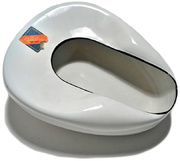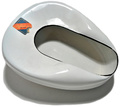
My mind’s been in the gutter lately. How else do you explain the conversation I had the other day with acclaimed author and inveterate collector Mike Bruner. As the keyboardist for Rare Earth (remember “Get Ready” and “I Just Want To Celebrate”?) and an authority on porcelain signs, glass insulators, and petroliana collectibles, to name but a few of his areas of expertise, Bruner is a true Renaissance man, as comfortable talking about history and technology as aesthetics and the arts.
So naturally, when we were speaking recently, I spent the whole time asking him about toilets.
“I love to collect things that were never meant to be collected.”
Actually, not the toilets themselves, but the floats that bobbed in the tanks behind them. Turns out, Bruner knows a fair amount about these curious footnotes to home-plumbing history. We’re not talking about your standard copper or plastic floats here, the ones you can still buy at Home Depot or Lowe’s. No, we’re talking about the glass toilet floats that were hand blown from the late 1800s until some time after World War I.
“That’s a really beautiful float,” he practically gushes when I ask him about a plain, innocuous-looking float with the words “Patent applied for” embossed on its side. “The glass on that, I just love. It’s very crude, but it’s probably the nicest appearing glass I have.”

Top: A C.D. Argent float. Above: This float show evidence of being hand blown and is possibly from the late 1800s.
I look again. It doesn’t seem all that remarkable to me, but Bruner’s vision is keener than mine. Where I see a boring oblong form, he sees history, and even art. “It’s obviously handmade, and I’d be willing to bet it could date to the 1800s,” he says. “It’s not symmetrical in its shape. It’s just what people who collect glassware want. They want something that tells a story. There’s no doubt that a human being made this thing. It went into a three-piece mold, so it’s definitely a production piece, but a human being blew the glass and snapped off the rod at the end. This thing is full of charisma.”
Like bottles from the same period, glass toilet floats can be dated by their pontil scars (or lack of) and mold marks, as well as the embossed legends on them, ascribing their production or distribution to long-since defunct businesses.

Floats were rarely produced in colors other than clear, which makes this aqua one rare.
“They are kind of an obscure collectible,” says Bruner, who is apparently also a master of the understatement. “There are not a whole lot of these things around.” In fact, toilet floats are such oddball outliers in the collectibles world, there aren’t even established prices for them, although you can expect to pay anywhere from $15 to $200 for a good one. Which means, alas, that you won’t become suddenly rich if you check your old toilet’s tank and find a glass float back there. Don’t quit that day job just yet.
One of the least common names found on toilet floats is C.D. Argent & Co. of New York, which was based in Brooklyn. “They were one of the earliest manufacturers,” Bruner says. “Their floats were not dated, but you can tell roughly how old they are by looking at the glass. My Argent actually has a pontil scar on the bottom of it, which means they were still hand-blowing these things.”

A Heap & Sons float dated 1907.
Other floats are easier to date. “I have one from William Heap & Sons of Grand Haven, Michigan, with a 1907 patent date on it, and an O.H. Jones of Hartford, Connecticut, from 1902. Glassmaking was quite common at the turn of the century,” Bruner adds. “Manufacturers made bottles, kitchen items, and utilitarian pieces used by industry.” A toilet float was just another product that could be cheaply and efficiently produced in glass rather than metal.
Which is not to say Bruner is convinced his floats labeled Argent, Heap, and Jones were actually manufactured by those companies. “As with other collectibles, the embossed names on these pieces of glassware do not necessarily reflect the actual manufacturer,” he says. “They could designate the parent company, the jobber, or the supply house. Who knows who made some of this glassware?”
Bruner has his theories. “Argent was possibly the agent that had things produced for the market and sold them to the trades but didn’t actually manufacture anything. A search on the Internet turns up no C.D. Argent glass manufacturer in Brooklyn, although there were glassmakers in the borough at that time.”

Floats were often blown into molds. Molded pieces like this one are often described as pleated.
Though he doesn’t have the evidence to prove it, Bruner thinks he knows who might have made some of his toilet floats. “One company that comes to mind is Rodefer Brothers, which was in the Ohio River Valley area.” Many glass houses, from Fenton to Fostoria to Anchor Hocking, were established there in the late 1800s and early 1900s. “It wouldn’t surprise me a bit if some of these floats came from that region,” Bruner says.
In fact, most of Bruner’s floats date to the first decade of the 20th century. And while floats were still being produced in the decade that followed, and also after World War I, the industry changed quickly. “Metal was introduced somewhere between the turn of the century and the 1920s,” he says. “I believe Kimble, Owens-Corning, and others made glass floats all the way up until the 1950s, but metal and plastic eventually took over. Kimble was about the last glass holdout.”
Here’s the kicker though: Turns out some of Bruner’s toilet floats may not have been designed for, or used in, toilets at all. “I’m not 100-percent sure that all these floats were destined to wind up in toilets,” Bruner sighs. “There were many industrial applications for floats, so there’s no guarantee that these things were originally sold for use in a toilet. Take that O.H. Jones float, for example. That might have been an industrial float. There were numerous applications in factories in which some kind of liquid in a tank needed to refill itself. You could use a float for that.”

This Jones float from 1902 may have been used for industrial purposes rather than in a toilet tank.
Bruner thinks a clue to this non-household use could be the band around the middle of the float. “Most floats had a little brass fitting molded into the glass. It was threaded so you could screw a rod into it. That’s your 100-percent giveaway that the piece of glass had something that had to do with the level of water or some other liquid, and fittings were common to floats used in toilet tanks. The O.H. Jones float has no metal fitting, but it does have a band, kind of a ‘saddle groove’, if you will, approximately four inches in diameter that went around the float, kind of like a belt around the waist. That’s how this float was held in position. So it’s definitely a float, likely used for an industrial purpose, possibly a toilet float.”
For a second time, I look again. Clearly Bruner can see more in these humble objects than I can. In fact, most of the people Bruner shows his floats to don’t know what they’re looking at at all. “When I show people my little collection of floats,” he says, “it’s amazing how many cannot guess what these things are. They’ll stare and stare, but they can’t identify them. And that is my gold standard. I love to collect things that were never meant to be collected. That’s my number-one priority in a collectible.”
(Photos courtesy Mike Bruner)

 Bill Lindsey on How To Read a Bottle
Bill Lindsey on How To Read a Bottle
 World's Foremost Bedpan Collector Celebrates Objects Most People Pooh-Pooh
World's Foremost Bedpan Collector Celebrates Objects Most People Pooh-Pooh Bill Lindsey on How To Read a Bottle
Bill Lindsey on How To Read a Bottle Garbage Pile Kids: Five Young Collectors Who Dig Rust, Dust, and Old Tobacco
Garbage Pile Kids: Five Young Collectors Who Dig Rust, Dust, and Old Tobacco Mari Tepper: Laying it on the Line
Mari Tepper: Laying it on the Line Nice Ice: Valerie Hammond on the Genteel Charm of Vintage Canadian Costume Jewelry
Nice Ice: Valerie Hammond on the Genteel Charm of Vintage Canadian Costume Jewelry How Jim Heimann Got Crazy for California Architecture
How Jim Heimann Got Crazy for California Architecture Modernist Man: Jock Peters May Be the Most Influential Architect You've Never Heard Of
Modernist Man: Jock Peters May Be the Most Influential Architect You've Never Heard Of Meet Cute: Were Kokeshi Dolls the Models for Hello Kitty, Pokemon, and Be@rbrick?
Meet Cute: Were Kokeshi Dolls the Models for Hello Kitty, Pokemon, and Be@rbrick? When the King of Comedy Posters Set His Surreal Sights on the World of Rock 'n' Roll
When the King of Comedy Posters Set His Surreal Sights on the World of Rock 'n' Roll How One Artist Makes New Art From Old Coloring Books and Found Photos
How One Artist Makes New Art From Old Coloring Books and Found Photos Say Cheese! How Bad Photography Has Changed Our Definition of Good Pictures
Say Cheese! How Bad Photography Has Changed Our Definition of Good Pictures Middle Earthenware: One Family's Quest to Reclaim Its Place in British Pottery History
Middle Earthenware: One Family's Quest to Reclaim Its Place in British Pottery History Fancy Fowl: How an Evil Sea Captain and a Beloved Queen Made the World Crave KFC
Fancy Fowl: How an Evil Sea Captain and a Beloved Queen Made the World Crave KFC
Mr. Marks,
After much searching, I determined that this rather odd and old-looking glass bulb that I found on an farmstead (1839) in Ashtabula County, Ohio, is a toilet tank float. Says PYREX / T.M.REg.U.S.PAT.OFF. / MADE IN USA / 12.
It is rather sturdy.
Am no expert, but appears it may have been blown into a mold. Has a seam on each side but a wavy line in the glass on the inside.
Can you tell me anything about this item, or refer my inquiry to Mr. Bruner? I am particulary interested in the history and time period of the float, as well as roughly what it might be worth.
Thanks,
James Darr
Hi Mr Marks,
I live in Australian and have recently discovered that the object I thought was a bottle is actually a glass toilet float. I have had this float for around 30 plus years. It has the Eisler’s Patent embossed on it and is made of clear glass measuring 6 ins high by 4.5 ins deep and in pretty good condition. There appears to have been a stopper in the top which might have been broken off flush with the top of the float but as this “break”is very even it might have originally been like that. Any information would be greatly appreciated.
Regards Ireen Lark
I’ve had a glass float at least 50 years at my home . It’s pleated I think ? is their a value to these things?
Mr. Darr-
As per your question about PYREX, I offer this. As one who grew up in Corning NY, and whose father was employed by Corning Inc. as a senior product designer, and whose mother was a librarian at CMOG, I know a bit more about glass than your average geek.
http://en.wikipedia.org/wiki/Pyrex
Info, I have a glass float with [ Patented 1916 ] embossed on it. One end is flat and stands like a bottle with a C embossed on the center of the flat..Maybe standing for Corning. The other end has a brass female threaded fitting with rubber on the unthreaded end that goes into the soda bottle like end sealing it from the water. It has a seam all the way to the top. Dave
I would like to get in contact with Irene Lark who asked a question from Australia earlier and any other float collectors. I have recently started collecting these in Australia. I would also like to contact Mike Brunner if at all possible. regards Graeme
My name is Colin Meadows from Brisbane, Australia have recently started bottle collecting. I have at least seven glass toilet floats 6″ wide 4 1/2 deep all have sealed glass necks 4 are clear 1 is aqua green 1 is coca cola colour 1 is faint blue all Eislers Patent interested to know what they are worth
I have a sort of bell shaped bottle with stopper that is not meant to come out I think about 4’wide and 6″ high marked” Eislers Patent” with no.L55 on the bottom
what was it for?????and is it collectable????? many thanks
Hi
I have a brown glass eislers ball float with the wire still around the head.Curious to know it’s value. Any info appreciated. I’m in Australia.
Ceramic bedpan with lid . Made by S.Maw.Son & Thompson at Aldersgate Street,London. I Would like to know its age & if it would be a collectors item.
I got a kimble glastite float. how old is it. its got a brass top. thank you brian
Loved Rare Earth, they’re on my phone! Who would have thought thought that? Something to start checking out in old home estate sales. You know slip into the bathroom look in the tank, ha ha. Who knows! Very interesting!
I have an old but in excellent condition, Slipper Bed Pan, it does not contain the word ‘new’ in the writing in the pan so I think it must be the a first version. I would like to know its age and if it is a collectors item?
Hoping you could tell us what the monetary value of the Heap and Sons glass float is worth that is dated 1907 on your website. Thank you in advance.
Did flea markets and “picked” for 51 years. Now opening old boxes to downsize and discovered I had acquired a 20th. Century Kimble toilet ball float. Read all of the previous inputs and checked pics but didn’t see any reference to my version. Mine has the name in raised letters around the ball’s middle horizontally. Has a C embossed on the slid tip and two small glass tabs at 180 & 360 degrees. It is clear heavy glass weighing 11 1/2 oz. Thank you. John
Google “glass floats (fishing) nets.” There’s millions that have “escaped” from their slavery of supporting fishing nets and often wash up on beaches. I think they are still used. More resistant to damage from sunshine than metal or plastic, and more damage resistant. They weigh more as the glass is thick. Tough as rocks, come in a large variety of sizes and shapes. (Some more than 300mm/12 inches in diameter which makes you think “explosive mine” at first sight because there were a few WWII era mines showing up too, they would break away from the rusted chains holding them to the seabed. In the same area (in the seas around Hong Kong in the early 60’s) I also saw a few escaped explosive mines . They would shoot the explosive ones with rifles until they exploded.